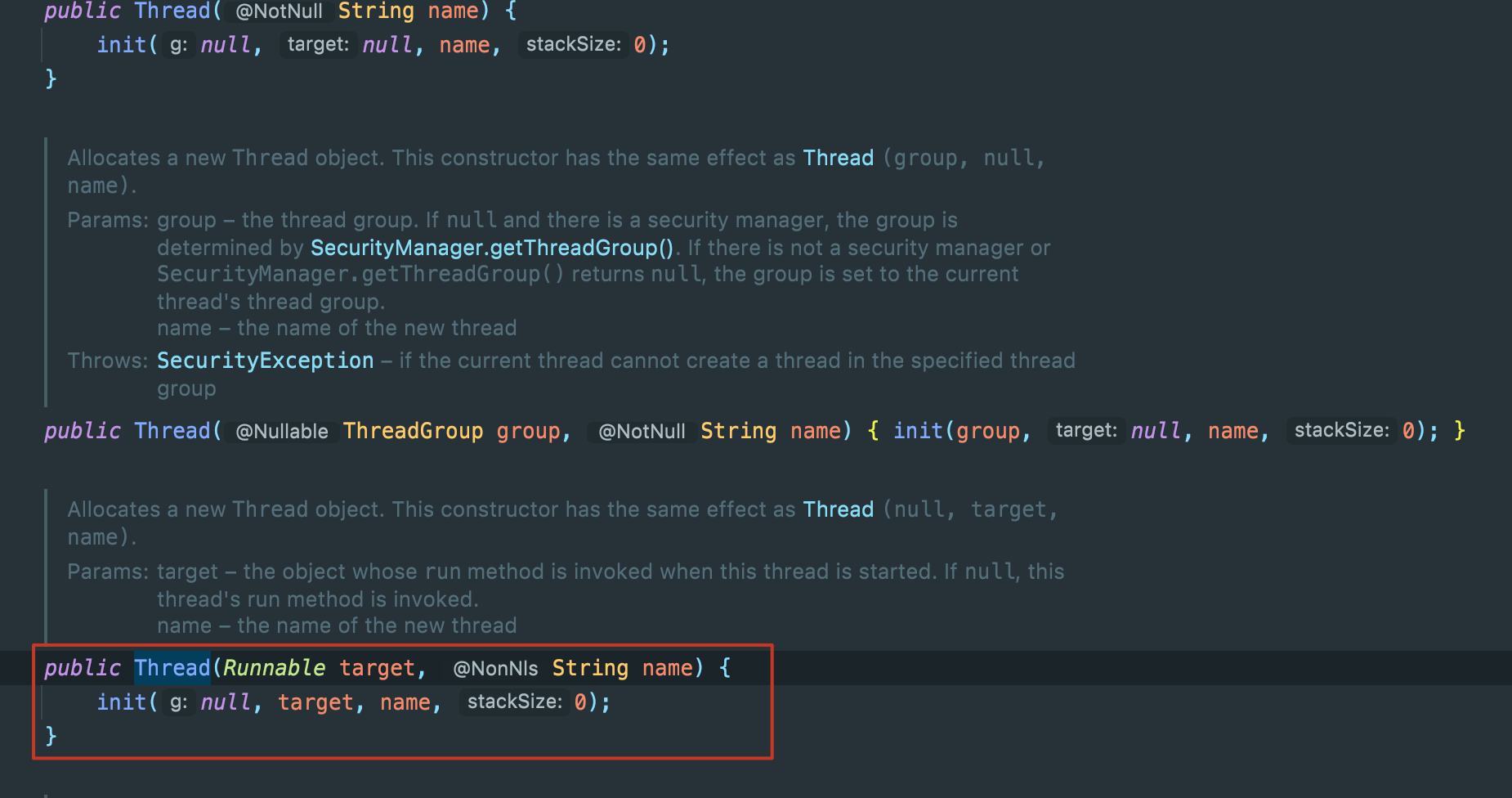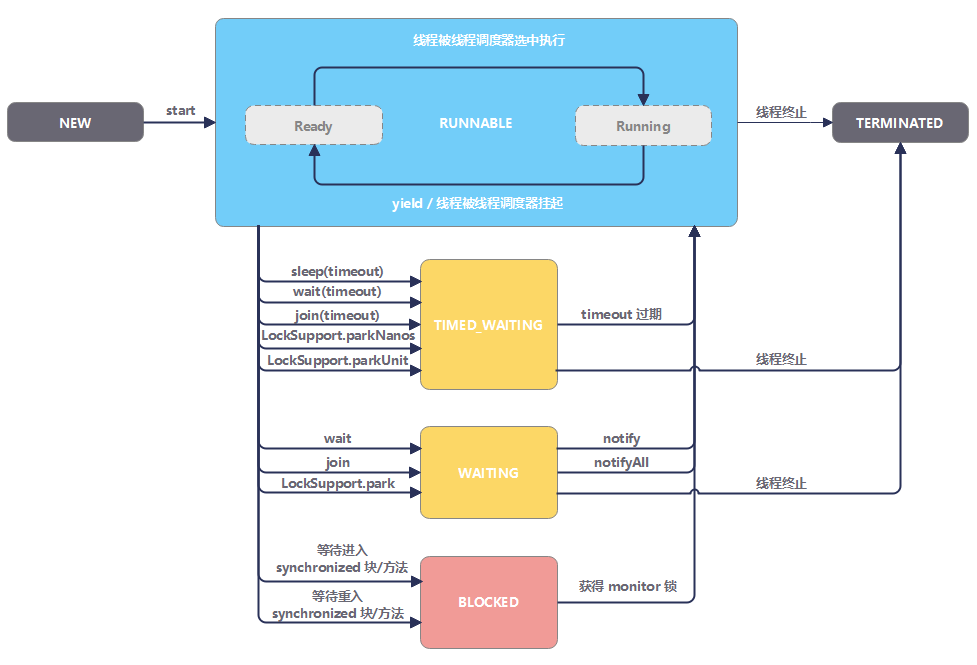如何创建线程
首先聊一下java线程和go协程的不同之处
在golang中,通过go关键字开启一个协程,执行匿名函数中的内容,此时main函数需要处于休眠模式下等待协程的运行,因为对golang而言,main函数线程结束则整个进程就结束了。
java分用户线程和守护线程(Daemon Thread)两个概念,其中main函数也是用户线程,只有当所有用户线程退出时,jvm进程才会结束。
Threat
使用Threat创建线程的方法
- 定义Threat类的子类,并重写该类的
run()方法。 - 创建Threat类的实例,即创建线程对象。
- 调用对象的
start()方法启动该线程。
package com.theoyu.concurrency;
public class ThreadDemo {
public static void main(String[] args) {
Thread thread1 = new MyThread("Thread-1");
Thread thread2 = new MyThread("Thread-2");
thread1.start();
thread2.start();
}
static class MyThread extends Thread {
public MyThread(String name){
super(name);
}
private int ticket =3 ;
@Override
public void run() {
while (ticket>0){
System.out.println(Thread.currentThread().getName()+" 卖出了第 "+ticket+" 张票 ");
try {
Thread.sleep(100);
} catch (InterruptedException e) {
e.printStackTrace();
}
ticket--;
}
}
}
}
输出:
Thread-1 卖出了第 3 张票
Thread-2 卖出了第 3 张票
Thread-1 卖出了第 2 张票
Thread-2 卖出了第 2 张票
Thread-1 卖出了第 1 张票
Thread-2 卖出了第 1 张票
Runnable
从Threat类的构造函数我们可以看到这样的重载

其中第三个重载,也就是传入Runnable接口

其实Threat本身也就是实现了Runnable,不过提供了更多的功能而已。
package com.theoyu.concurrency;
public class RunnableDemo {
public static void main(String[] args) {
Thread thread1 = new Thread(new MyThread(),"Thread-1");
Thread thread2 = new Thread(new MyThread(),"Thread-2");
thread1.start();
thread2.start();
}
static class MyThread implements Runnable {
private int ticket = 3;
@Override
public void run() {
while (ticket > 0) {
System.out.println(Thread.currentThread().getName() + " 卖出了第 " + ticket + " 张票 ");
try {
Thread.sleep(100);
} catch (InterruptedException e) {
e.printStackTrace();
}
ticket--;
}
}
}
}
在第一个方法里,我们理解为子类重写了父类的方法,那么在Runnable中,是怎么执行到其重写的run方法呢?
在start()方法里,我们可以看见重写的run()方法,这里对target(Runnable)进行了判断,于是乎就走到了target.run()中。
@Override
public void run() {
if (target != null) {
target.run();
}
}
这里谈一下start()和run()的区别,在第一个方法中,如果我们把threat1的start改为run,会怎么样呢?
package com.theoyu.concurrency;
public class ThreadDemo {
public static void main(String[] args) {
Thread thread1 = new MyThread("Thread-1");
Thread thread2 = new MyThread("Thread-2");
thread1.run();
thread2.start();
}
static class MyThread extends Thread {
public MyThread(String name){
super(name);
}
private int ticket =3 ;
@Override
public void run() {
while (ticket>0){
System.out.println(Thread.currentThread().getName()+" 卖出了第 "+ticket+" 张票 ");
try {
Thread.sleep(100);
} catch (InterruptedException e) {
e.printStackTrace();
}
ticket--;
}
}
}
}
结果:
main 卖出了第 3 张票
main 卖出了第 2 张票
main 卖出了第 1 张票
Thread-2 卖出了第 3 张票
Thread-2 卖出了第 2 张票
Thread-2 卖出了第 1 张票
可以看到thread1.run()并没有开启新的线程,相当于只是在main线程中执行了一个普通方法,具体创建线程的函数在start()的private native void start0()中,所以必须使用start()启动线程,jvm让这个线程去执行run()方法。
线程的基础用法
线程休眠
Thread.sleep,这个没什么好说的,但注意Thread.sleep可能会抛出 InterruptedException,java线程的异常必须在该线程中处理。
中断线程
回想在go中,如何通知一个协程关闭呢?golang退出协程的几种方式
之前提到了go不推荐用共享全局变量的方式进行数据交互,但在java中恰好相反,简单来说安全地终止线程,java有以下两种方式:
-
对目标线程使用
interrupt()方法配合线程中的检测退出。 -
使用
volatile关键字,在run方法中配合退出。先看看第一种方式,只要在其他线程中对目标线程使用
interrupt()方法,目标线程只需检查自身的interrupted状态,即可控制退出:
package com.theoyu.concurrency.foundation;
public class InterruptDemo1 {
public static void main(String[] args) throws InterruptedException {
Thread t = new MyThread();
t.start();
Thread.sleep(1);
t.interrupt();
t.join();
System.out.println("end");
}
static class MyThread extends Thread {
public void run() {
int n = 0;
while (! isInterrupted()) {
n ++;
System.out.println(n + " hello!");
}
}
}
}
这里在run()方法的while循环中持续监测isInterrupted()状态,在main线程休眠1毫秒后,对目标线程发送信号,退出while循环结束run() 方法
...
...
106 hello!
107 hello!
108 hello!
end
其实,interrupt()只是向目标线程发送了“中断请求”,至于目标线程能不能退出,还得看具体代码实现。
如果目标线程处于等待状态,对其发送“中断请求”则会抛出InterruptedException异常,此时只需处理异常并退出即可
package com.theoyu.concurrency.foundation;
public class InterruptDemo2 {
public static void main(String[] args) throws InterruptedException {
Thread t = new InterruptDemo2.MyThread();
t.start();
t.interrupt();
t.join();
System.out.println("end");
}
static class MyThread extends Thread {
public void run() {
int n = 0;
try {
Thread.sleep(1000*10);
} catch (InterruptedException e) {
System.out.println("线程 "+currentThread().getName()+" 线程休眠被终止");
return;
}
System.out.println("线程 "+currentThread().getName()+" 正常结束");
}
}
}
线程 Thread-0 线程休眠被终止
end
再来看看另外一种使用关键字的方法退出
package com.theoyu.concurrency.foundation;
public class VolatileDemo {
public static void main(String[] args) throws InterruptedException {
MyThread t = new MyThread();
t.start();
Thread.sleep(1);
t.running = false; // 标志位置为false
}
static class MyThread extends Thread {
public volatile boolean running = true;
public void run() {
int n = 0;
while (running) {
n++;
System.out.println(n + " hello!");
}
System.out.println("end!");
}
}
}
...
...
135 hello!
136 hello!
end!
线程礼让
Thread.yield 方法的调用声明了当前线程已经完成了生命周期中最重要的部分,把该线程从running切换为ready,但该线程还是处于runnable态。
但是礼让不一定成功,即使A礼让B,A还是有可能再次抢到cpu的资源,具体还要看cpu的调度。
线程同步
如果多个线程同时读写共享变量,会出现数据不一致的问题。
这是因为对变量进行读取和写入,必须要求是原子操作。
例如对于语句
n = n + 1;
其bytecode对应三条指令
ILOAD
IADD
ISTORE
如果两个线程同时执行n=n+1,结果可能只会加一次:
┌───────┐ ┌───────┐
│Thread1│ │Thread2│
└───┬───┘ └───┬───┘
│ │
│ILOAD (n) │
│ │ILOAD (n)
│ │IADD
│ │ISTORE (n+1)
│IADD │
│ISTORE (n+1)│
▼ ▼
加锁后:
┌───────┐ ┌───────┐
│Thread1│ │Thread2│
└───┬───┘ └───┬───┘
│ │
│-- lock -- │
│ILOAD (n) │
│IADD │
│ISTORE (n+1) │
│-- unlock -- │
│ │-- lock --
│ │ILOAD (n+1)
│ │IADD
│ │ISTORE (n+2)
│ │-- unlock --
▼ ▼
使用synchronized关键字对一个对象进行加锁
package com.theoyu.concurrency.foundation;
public class SyncDemo1 {
public static void main(String[] args) throws Exception {
Thread add = new AddThread();
Thread dec = new DecThread();
add.start();
dec.start();
add.join();
dec.join();
System.out.println(Counter.count);
}
static class Counter {
public static final Object lock = new Object();
public static int count = 0;
}
static class AddThread extends Thread {
public void run() {
synchronized (Counter.lock) {
for (int i = 0; i < 10000; i++) {
Counter.count += 1;
}
}
}
}
static class DecThread extends Thread {
public void run() {
synchronized (Counter.lock) {
for (int i = 0; i < 10000; i++) {
Counter.count -= 1;
}
}
}
}
}
上述代码还可以进行修改, synchronized可以用于实例方法同步,此时同步的也就是拥有该方法的对象上。
package com.theoyu.concurrency.foundation;
public class SyncDemo2 {
public static void main(String[] args) throws Exception {
Thread add = new AddThread();
Thread dec = new DecThread();
add.start();
dec.start();
add.join();
dec.join();
System.out.println(Counter.count);
}
static class Counter {
public synchronized static void countDec() {
count--;
}
public synchronized static void countAdd() {
count++;
}
public static int count = 0;
}
static class AddThread extends Thread {
public void run() {
for (int i = 0; i < 10000; i++) {
Counter.countAdd();
}
}
}
static class DecThread extends Thread {
public void run() {
for (int i = 0; i < 10000; i++) {
Counter.countDec();
}
}
}
}
守护线程
正如开头所说的,java程序入口是main线程,main线程启动其他线程。
java分为用户线程(User Thread)和守护线程(Daemon Thread),守护线程是在后台运行不会组织jvm终止的线程,当所有用户线程结束时,jvm进程也就退出,同时会杀死所有守护线程。
Daemon的作用是为其他线程的运行提供便利服务,守护线程最典型的应用就是 GC (垃圾回收器),它就是一个很称职的守护者。
设置守护线程需要注意几点:
- 正在运行的线程无法设置为守护线程,即
thread.setDaemon(true)必须在thread.start()之前设置,否则会抛出IllegalThreadStateException异常 - 在Daemon线程中产生的新线程也是Daemon。
- 和数据读写相关的操作最好不要设置为Daemon:无法控制结束。
package com.theoyu.concurrency.foundation;
public class DaemonDemo {
public static void main(String[] args) throws InterruptedException {
Thread t = new Thread(new MyThread(), "线程");
t.setDaemon(true); // 此线程在后台运行
System.out.println("线程 t 是否是守护进程:" + t.isDaemon());
t.start(); // 启动线程
Thread.sleep(1);
}
static class MyThread implements Runnable {
@Override
public void run() {
while (true) {
System.out.println(Thread.currentThread().getName() + "在运行。");
}
}
}
}
线程间的通信
-
wait会自动释放当前线程占有的对象锁,并请求操作系统挂起当前线程,让线程从Running状态转入Waiting状态,等待notify/notifyAll来唤醒。如果没有释放锁,那么其它线程就无法进入对象的同步方法或者同步控制块中,那么就无法执行notify或者notifyAll来唤醒挂起的线程,造成死锁。 notify- 唤醒一个正在Waiting状态的线程,并让它拿到对象锁,具体唤醒哪一个线程由 JVM 控制 。notifyAll- 唤醒所有正在Waiting状态的线程,接下来它们需要竞争对象锁。
看一个网上广为流传的生产者消费者例子:
package com.theoyu.concurrency.foundation;
import java.util.PriorityQueue;
public class WaitDemo1 {
private static final int QUEUE_SIZE = 10;
private static final PriorityQueue<Integer> queue = new PriorityQueue<>(QUEUE_SIZE);
public static void main(String[] args) {
new Producer("生产者A").start();
new Producer("生产者B").start();
new Consumer("消费者A").start();
new Consumer("消费者B").start();
}
static class Consumer extends Thread {
Consumer(String name) {
super(name);
}
@Override
public void run() {
while (true) {
synchronized (queue) {
while (queue.size() == 0) {
try {
System.out.println("队列空,等待数据");
queue.wait();
} catch (InterruptedException e) {
e.printStackTrace();
queue.notifyAll();
}
}
queue.poll(); // 每次移走队首元素
queue.notifyAll();
try {
Thread.sleep(500);
} catch (InterruptedException e) {
e.printStackTrace();
}
System.out.println(Thread.currentThread().getName() + " 从队列取走一个元素,队列当前有:" + queue.size() + "个元素");
}
}
}
}
static class Producer extends Thread {
Producer(String name) {
super(name);
}
@Override
public void run() {
while (true) {
synchronized (queue) {
while (queue.size() == QUEUE_SIZE) {
try {
System.out.println("队列满,等待有空余空间");
queue.wait();
} catch (InterruptedException e) {
e.printStackTrace();
queue.notifyAll();
}
}
queue.offer(1); // 每次插入一个元素
queue.notifyAll();
try {
Thread.sleep(500);
} catch (InterruptedException e) {
e.printStackTrace();
}
System.out.println(Thread.currentThread().getName() + " 向队列取中插入一个元素,队列当前有:" + queue.size() + "个元素");
}
}
}
}
}
输出:
生产者A 向队列取中插入一个元素,队列当前有:1个元素
生产者A 向队列取中插入一个元素,队列当前有:2个元素
生产者A 向队列取中插入一个元素,队列当前有:3个元素
生产者A 向队列取中插入一个元素,队列当前有:4个元素
生产者A 向队列取中插入一个元素,队列当前有:5个元素
生产者A 向队列取中插入一个元素,队列当前有:6个元素
生产者A 向队列取中插入一个元素,队列当前有:7个元素
生产者A 向队列取中插入一个元素,队列当前有:8个元素
生产者A 向队列取中插入一个元素,队列当前有:9个元素
生产者A 向队列取中插入一个元素,队列当前有:10个元素
队列满,等待有空余空间
消费者B 从队列取走一个元素,队列当前有:9个元素
消费者B 从队列取走一个元素,队列当前有:8个元素
...
其实这对我们预想的有一些出入,按道理queue.notifyAll()会唤醒所有的进程,应该是一个消费者和生产者交替消费和生产的过程,但是这里好像失败了。
原因在于queue.notifyAll()后,当前线程还是处于synchronized下,其他线程会再次被挂起,这里改一下输出语句和sleep的位置即可:
package com.theoyu.concurrency.foundation;
import java.util.PriorityQueue;
public class WaitDemo2 {
private static final int QUEUE_SIZE = 10;
private static final PriorityQueue<Integer> queue = new PriorityQueue<>(QUEUE_SIZE);
public static void main(String[] args) {
new Producer("生产者A").start();
new Producer("生产者B").start();
new Consumer("消费者A").start();
new Consumer("消费者B").start();
}
static class Consumer extends Thread {
Consumer(String name) {
super(name);
}
@Override
public void run() {
while (true) {
try {
Thread.sleep(500);
} catch (InterruptedException e) {
e.printStackTrace();
}
synchronized (queue) {
while (queue.size() == 0) {
try {
System.out.println("队列空,等待数据");
queue.wait();
} catch (InterruptedException e) {
e.printStackTrace();
queue.notifyAll();
}
}
queue.poll(); // 每次移走队首元素
System.out.println(Thread.currentThread().getName() + " 从队列取走一个元素,队列当前有:" + queue.size() + "个元素");
queue.notifyAll();
}
}
}
}
static class Producer extends Thread {
Producer(String name) {
super(name);
}
@Override
public void run() {
while (true) {
try {
Thread.sleep(500);
} catch (InterruptedException e) {
e.printStackTrace();
}
synchronized (queue) {
while (queue.size() == QUEUE_SIZE) {
try {
System.out.println("队列满,等待有空余空间");
queue.wait();
} catch (InterruptedException e) {
e.printStackTrace();
queue.notifyAll();
}
}
queue.offer(1); // 每次插入一个元素
System.out.println(Thread.currentThread().getName() + " 向队列取中插入一个元素,队列当前有:" + queue.size() + "个元素");
queue.notifyAll();
}
}
}
}
}
输出:
生产者B 向队列取中插入一个元素,队列当前有:1个元素
生产者A 向队列取中插入一个元素,队列当前有:2个元素
消费者A 从队列取走一个元素,队列当前有:1个元素
消费者B 从队列取走一个元素,队列当前有:0个元素
队列空,等待数据
生产者B 向队列取中插入一个元素,队列当前有:1个元素
消费者B 从队列取走一个元素,队列当前有:0个元素
生产者A 向队列取中插入一个元素,队列当前有:1个元素
消费者A 从队列取走一个元素,队列当前有:0个元素
...
...
线程的生命周期
一个线程对象只能调用一次start()方法,多次调用会抛出IllegalThreadStateException错误,并且新线程的run()方法执行完毕,线程也就结束了,java的线程状态分为以下几种:
┌─────────────┐
│ New │
└─────────────┘
│
▼
┌ ─ ─ ─ ─ ─ ─ ─ ─ ─ ─ ─ ─ ─ ─ ─ ┐
┌─────────────┐ ┌─────────────┐
││ Runnable │ │ Blocked ││
└─────────────┘ └─────────────┘
│┌─────────────┐ ┌─────────────┐│
│ Waiting │ │Timed Waiting│
│└─────────────┘ └─────────────┘│
─ ─ ─ ─ ─ ─ ─ ─ ─ ─ ─ ─ ─ ─ ─ ─
│
▼
┌─────────────┐
│ Terminated │
└─────────────┘
- 新建(New):尚未调用
start()的线程处于此状态。 - 就绪(Runnable):已经调用了
start方法的线程处于此状态。此状态意味着:线程已经在 JVM 中运行。但是在操作系统层面,线程可能处于running,也有可能处于ready,这取决于操作系统的资源调度。 - 阻塞(Blocked):此状态表示线程在等待
synchronized的隐式锁(Monitor lock)。synchronized修饰的方法、代码块同一时刻只允许一个线程执行,其他线程只能等待,即处于阻塞状态。当占用synchronized隐式锁的线程释放锁,并且等待的线程获得synchronized隐式锁时,就又会从BLOCKED转换到RUNNABLE状态。 - 等待(Waiting):;此状态意味着:线程无限期等待,直到被其他线程显式地唤醒。 阻塞和等待的区别在于,阻塞是被动的,它是在等待获取
synchronized的隐式锁。而等待是主动的,通过调用Object.wait等方法进入。 - 定时等待(Timed Waiting):此状态意味着:无需等待其它线程显式地唤醒,在一定时间之后会被系统自动唤醒。
- 终止(Terminated):线程执行完 run 方法,或者因异常退出了 run 方法。此状态意味着:线程结束了生命周期。
用@javacore的一幅图来表示:

从bytecode看java并发
好像考试周,只要干和考试无关的,都会非常有意思……
🐦🐦🐦🐦🐦🐦考完试再补